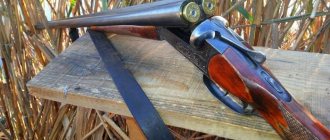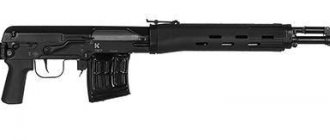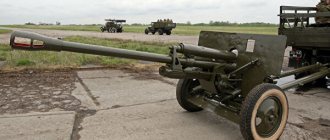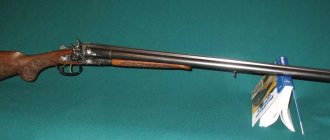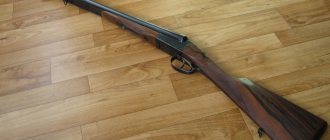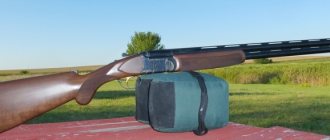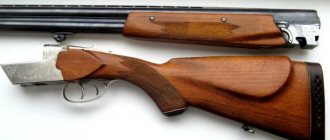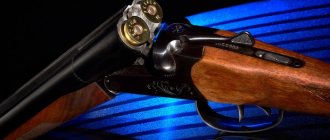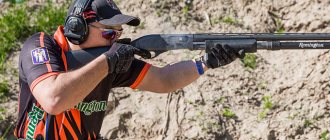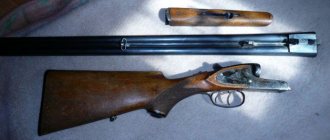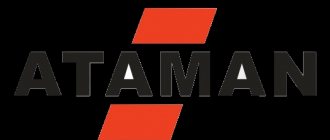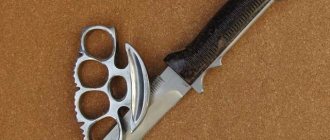Currently, old Soviet hunting rifles are in great demand among experienced hunters. Unlike the new models, most guns produced in the USSR were distinguished by higher quality assembly. For example, the IZH-58 hunting rifle from IZHMASH, which is almost completely similar to the modern IZH-43, is made of higher quality, and they did not skimp on materials in Soviet times.
The classic IZH-58 double-barreled shotgun has long earned a reputation as a reliable and problem-free weapon, although those hunters who also used the IZH-54 note that the quality of the new gun was significantly worse than that of its predecessor.
Since IZH-54 is almost impossible to get, buying an IZH-58 is a very profitable investment for a hunter. In addition, such a gun can often be bought for literally pennies, since many, having inherited it, simply do not have documents for storing weapons.
The purpose of the double-barreled shotgun IZH-58
This hunting rifle was originally conceived as a light weapon intended for hunting birds and small fur-bearing animals. However, huge demand forced IZHMASH to reconsider the original decision and release the IZH-58 12 gauge, which was the most popular among domestic hunters.
Since the gun was developed on the basis of the IZH-54, the technical characteristics of which were always at their best, the double-barreled shotgun had a number of the following qualities:
- Reliability;
- Appropriateness;
- Excellent balance;
- Simplicity of design.
The double-barreled shotgun, which absorbed all the positive qualities of its predecessors, turned out to be powerful and accurate. Judging by the reviews of hunters, the IZH-58 of any caliber is extremely unpretentious in terms of the quality of ammunition, although when hunting large animals it is better to choose cartridges from a trusted manufacturer.
You can shoot from this weapon with shot, buckshot or bullet. In any case, the shooting results will satisfy even the most demanding hunter. Since the IZH-58 barrel is made of high-quality weapon steel, the lifespan of the gun can reach 50,000 shots, although the manufacturer only gave a guarantee for 15,000 shots.
In Soviet times, the gun was distinguished by its extremely low price, which the manufacturer was able to achieve by reducing the amount of manual labor in the production of this model. Although this reduced build quality, the low price and simplicity of design did the trick: it became the most popular hunting weapon in the period from the 1960s to the 1980s.
The management of IZHMASH has repeatedly made attempts to replace the IZH-58 with a more modern model, but a huge number of domestic hunters demanded to continue the production of this high-quality, and most importantly, inexpensive weapon.
The double-barreled shotgun was produced in both serial and piece versions, which were distinguished by higher quality assembly and finishing. To order, the plant even produced souvenir models of various calibers, which had a rich finish on the stock and butt.
The history of the appearance of IZH-58
The history of IZH-58 began in 1958. It was then that the IZHMASH design group, led by Pugachev, created a new hunting weapon, which became much more technologically advanced than all previous models of the plant. During assembly, the share of manual labor was significantly reduced, lower quality materials and other technology began to be used. Now the assembly of the new gun model was several times faster, which made it possible to significantly reduce the price of the finished product.
Naturally, such a simplification of production could not have a positive effect on the quality of the finished gun. Compared to IZH-54, the new model has become significantly worse.
The IZH-58 shotgun was assembled using an almost conveyor belt method, and from year to year the manufacturability of production increased, turning IZHMASH products into an ordinary, unremarkable “serial series”. As an example, we can cite the story of the failure to install water pipes that were still in the first batches. Since the installation of fire pipes required exclusively manual labor, they decided to abandon their installation, which made it possible to further reduce the price of the finished product by increasing the manufacturability of production.
As a result of such modernizations, hunters, accustomed to the high quality of the IZH-54 and seduced by the low price of the IZH-58 gun, literally swept these weapons off the shelves of gun stores.
Fundamentals of the design of the IZH-58 shotgun and its differences from its predecessors
In order to reduce the cost of a hunting double-barreled shotgun as much as possible, IZHMASH designers had to take the following measures:
- To avoid the installation of chrome-plated fire pipes, which were still found on the IZH-58 in the first batches, it was decided to make the block from high-quality tool steel, which did not require long-term heat treatment. In this regard, it was also possible to abandon manual fitting of the block, since the absence of heat treatment guaranteed the stable condition of this unit. Despite this, everyone understood perfectly well that no stamping could replace manual work, but the requirements to reduce the cost of the gun and increase the rate of production had to be met;
- Most of the screws, which on the IZH-54 had not only different diameters, but also different thread pitches, were replaced with simple pins. This significantly simplified the life of the collectors, who were now chasing only quantity, trying to earn more;
- The buttstock began to be attached to the block according to a simpler scheme - due to the coupling that tightened the breech. This type of connection does not require long and painstaking silver soldering along the entire length of the barrel, and it is also considered more reliable. Now the barrels were fastened together by two slats, one of which simultaneously served as a sighting bar;
- The reliable mainsprings that were installed on the IZH-54 were plate-type. Springs of this type are still installed on high-price hunting rifles. The designers of IZH-58 considered it inappropriate to use springs of this type, and replaced them with simple twisted springs.
All these measures made it possible to significantly speed up the production process and reduce the price of the finished product. At the same time, the build quality and reliability for which the IZH-54 hunting rifle was famous has dropped.
Description of the design of IZH-58
A double-barreled hunting shotgun is a classic hunting rifle with horizontally positioned barrels. High-quality weapon steel was used to make the barrels and blocks. The weapon's barrel coupling has special under-barrel hooks and a stepped protrusion. To increase the service life of the gun, the chambers and bores were chrome-plated. The outer metal parts of the gun were oxidized to make them resistant to corrosion.
The triggers have pressed-in strikers with a release mechanism. It is almost impossible to determine externally whether they are cocked or not. The trigger release is made smooth, which helps improve shooting accuracy. To ensure safety, a scheme has been implemented to automatically reset hammers that have fallen from cocking to the safety cocking.
The first models used a non-automatic fuse that locked the sear. Later models received an automatic safety, which is still used on modern IZH horizontal hunting double-barreled shotguns.
The IZH-58 shotgun, 20 caliber, received a recessed inter-barrel rib made during the stamping process. On IZH-58 caliber 16 and other calibers, the inter-barrel rail was of a standard type.
The standard IZH-58 models of 12.16 and 20 caliber were equipped with a forend and stock made of birch or beech. There are no particular complaints about these parts of the gun, although over time the stock may crack or split, especially if used carelessly. On the one-piece models, the butt and fore-end were made of high-quality walnut wood, the assembly was carried out to a higher quality, and the best barrels were selected for these guns.
Application
The IZH-58 shotgun is used for commercial and sport hunting. Shots of various diameters, buckshot and solid lead bullets can be used to load cartridges.
The use of a combined barrel design (choke and half-barrel) made it possible to increase the accuracy of fire over a wide range of distances.
For storage and transportation, the weapon is disassembled into three parts - the fore-end, the barrels and the stock along with the butt. When disassembled, the IZH-58 does not take up much space and is easy to carry and transport.
After firing from the right barrel and loading the left one, it is recommended to move the cartridge from the left channel to the right one, and install a new one in the left one.
The automatic fuse is often turned off because removing it is accompanied by a loud, dry click that scares the animal away.
The non-automatic operating mode ensures safe operation of the weapon.
It is worth noting such a disadvantage of weapons as susceptibility to corrosion; due to the poor quality of chemical processing of metal parts and the low durability of the coating, the metal of the gun is prone to corrosion. It is for this reason that when cleaning this weapon you should be careful about removing moisture.
The big advantage of the weapon is its durability. The documentation never indicated the service life of the weapon, but, according to most owners, it is about 7...8 thousand shots. At the same time, there are examples of guns produced in the early 60s, of which at least 15...20 thousand shots were fired.
Model range IZH-58
An interesting point in the history of the gun was that this double-barreled shotgun was not conceived at all as an alternative to the IZH-54. Since it was necessary to create a light gun for hunting fur-bearing animals, designer Pugachev developed the IZH-58 as a 20-caliber gun, after which it was planned to also develop a 28-caliber gun. But since the fifty-eighth turned out to be a very technologically advanced and inexpensive model, especially compared to the labor costs for the production of IZH-54, it was decided to expand the IZH-58 model range.
As it turned out, the 12 and 16 gauge models became the most popular. 20-caliber shotguns were not in particular demand, and 28-caliber shotguns were made only to order, and even then only in the first years of production. Soon, the production of IZH-58 28 caliber was considered unprofitable, and it was completely discontinued.
Initially, the gun was produced only in 20 gauge. After some time, the plant began producing 16-gauge shotguns, and soon 12-gauge ones. Over the course of more than 30 years of production of the IZH-58, the double-barreled shotgun was constantly modernized, trying to maximize the manufacturability of production and reduce the final price of the weapon for the consumer. At the same time, the quality of the guns produced remained virtually unchanged, although if you compare the IZH-58 of the first years of production with the IZH-58 of the last years of production, you can see that the increase in production technology did not have the best effect on the quality.
Since Soviet hunters were not picky, and the price was more than low, this double-barreled shotgun became incredibly popular throughout the USSR. In addition, about 10% of guns were exported outside the USSR.
The presented weapons were produced in the following modifications:
- IZH-58-20 - a 20-caliber shotgun, the very first in the IZH-58 line;
- IZH-58-16 – 16 gauge double-barreled shotgun;
- IZH-58-12 - a 12-gauge shotgun, the most popular among Soviet hunters;
- IZH-58-28 is a 28-caliber shotgun, which was produced only to order.
The last guns were released in the early 70s. In 1971, the plant began producing modernized shotguns called IZH-58M.
The purpose of the gun and its fighting qualities
At the very beginning of the idea, the gun was planned to be produced for fishermen in 20 and 28 calibers, but the requirements of the time and demand gave rise to 16 and 12 gauges, which gained great popularity.
The excellent balance of this weapon and excellent accuracy of combat allow you to fire not only with shot or buckshot, but also with a bullet.
Thus, you can go on any hunt with such a double-barreled shotgun. The disadvantage of the gun is that the trigger is too tight, but this can be easily corrected.
According to the manufacturer's data, the weapon can withstand about seven thousand shots, but in practice this figure can easily be doubled if you properly care for and operate the gun.
IZH-58M and its modifications
Since 1971, the Izhevsk plant began to produce a modification of the IZH-58M, which was an improved model. The design was based on some components from IZH-48. The first gun in the line was the IZH-58M-16. Soon after this, the 12 gauge shotgun was created. If you look at the documents from those years, you can see that over the years of production, about half of all guns were exported, as the build quality became higher.
In 1977, two more modifications were created based on the IZH-58M:
- IZH-58MA;
- IZH-58MAE.
The IZH-58MA shotgun received an automatic safety lock, and the IZH-58MAE also received an ejector mechanism, which ensured automatic removal of spent cartridges when opening the gun barrels. These modifications were also supplied abroad, and were in stable demand there.
In 1979, the IZH-58MA-20M model appeared, which was designed to use 20/76 magnum cartridges, which were very popular abroad at that time. Most of the guns of this model were sold for export.
The IZH-58 shotgun in various modifications was produced in huge quantities, so it is still very popular among hunters in Russia and the CIS. Since it is now very difficult to get the IZH-54, the IZH-58 is a very good option for novice hunters. It is light, reliable and very low maintenance. When purchasing, it is advisable to look for one-piece specimens and pay attention to the condition of the bores and the general condition of the double-barreled shotgun.
Design and performance characteristics
The design of the IZH-58 hunting rifle uses a horizontal layout of two interchangeable barrels. The design of the barrels is different - the right channel has a narrowing of the wedge type (narrowing 0.5 mm), and the left one has a choke type (narrowing 1 mm).
Both bores and chambers have a chrome-plated interior. Until 1961, barrels with a length of 750 mm were used, which was then reduced by 25 mm. At the same time, the barrels of IZH-58 shotguns from different batches may differ in length by 10 mm. Such a difference was considered the norm at the Izhevsk plant in the mass production of hunting weapons.
The outside of early gun barrels could be coated with a chemical-based protective paint or coated with a layer of dark chrome.
Subsequently (from about 1961), a simpler and cheaper chemical dyeing technology began to be used.
The type of processing is listed in the passport attached to each IZH-58. The values of the barrel diameters are marked in the form of a mark on the barrel coupling area. In addition, there is information about the year of manufacture, the maximum permissible pressure in the chamber channel and the serial number of the weapon. The number is additionally stamped on the plane of the front locking hook.
The barrel block is secured with a locking bar and three hooks. A pair of hooks are installed under the block (Perdet scheme) and one above the trunks. The mechanism is locked using a rotary lever. When shooting, the use of smoky and smokeless powder is allowed.
Between the barrels there is a bar on which the front sight is located. Shotguns manufactured before 1960 have a high rib that protrudes above the surface of the barrels.
The IZH-58 trigger mechanism is mounted in a special block and on a base riveted to the lower plane of the block.
The design of the triggers has strikers and safety cocks. The hammers are cocked and the mainsprings are compressed when the barrels are broken.
If an automatic fuse is used, it is retracted to the rear position and secures the sear. The automatic safety device can be turned off by turning the device's thrust 180 degrees.
Removal of spent cartridges from the barrel is performed automatically or semi-automatically (depending on the model). In semi-automatic mode, the cartridge case moves slightly out of the bore and is removed manually.
When installing a machine gun, only the spent cartridge case is ejected; the entire cartridge is only extended 3 mm. To equip cartridges, cartridge cases made of any material (including metal) can be used.
The mechanism for automatically removing sleeves is called ejector and can be turned off by turning the middle lever of the device. In this case, the cartridges are simply pulled out a little from the barrel and removed manually.
The wooden parts of IZH-58 guns were made of birch or beech and covered with several layers of protective varnish.
The material of manufacture was indicated in the gun's passport. For early releases of guns, walnut wood may have been used, but in fact such weapons are not found.
It is possible that single and single copies of the IZH-58 were equipped with walnut butts. A fine notch was applied to the stock, but several examples of early production guns with large patterns on the stock are known.
It should be noted that early guns were equipped with a stock with a straight neck on the stock, the so-called “English” type. A metal butt plate was installed on the back of such butts.
From the first half of the 60s, the use of stock elements with a “semi-pistol” type handle and plastic butt pads began. For some time, both designs were used in parallel.
The type of stock is indicated in the product passport. Plastic butt plates of IZH-58 shotguns of different years of production may have a different color and a different location of the Izhevsk Arms Plant mark.
A feature of the early versions of the weapon is a rotating swivel screwed to the dividing strip between the barrels.
Subsequently (approximately after 1960) it was replaced by a fixed structure.
Each IZH-58 smoothbore shotgun was tested at the manufacturer's factory. For control testing, no more than three cartridges were used per barrel.
Shooting was carried out at a target with a diameter of 750 mm from a distance of 35 meters. The weapon was considered suitable for use if at least one of the shots met the following parameters:
- The number of pellet hits from the right barrel is at least 50%.
- A similar parameter for the left should be at least 60%.
The results of the shooting were recorded in the weapon passport. In addition, the stamp indicated the type of gunpowder used, its weight and the type of shot used. To test the strength, a shot with an enhanced charge of smokeless powder was used.
At the same time, the pressure in the 20-caliber barrel could reach 850 atmospheres, which exceeded the standard parameter. When testing large-caliber guns, the test pressure was 50...100 atmospheres higher.
Performance characteristics
| Parameter | IZH-58-12 | IZH-58-16 |
| Caliber | 12 | 16 |
| Barrel length, mm | 725 (on early series 750) | |
| Breech diameter, mm | 18,2 | 17 |
| Weight, no more than, g | 3200 | |
| Working pressure in the channel, no more than, atm. | 700…750 | |
| Test pressure, atm. | 900 | 950 |
Rarely found today, 20-gauge shotguns were equipped with barrels with a length of 675 mm and weighed in the range of 2700...2900 g. The diameter of the breech of the barrels was 15.5 mm.
